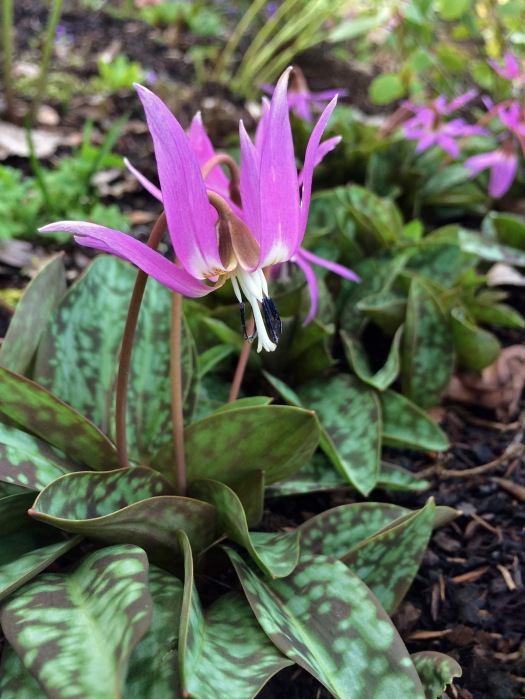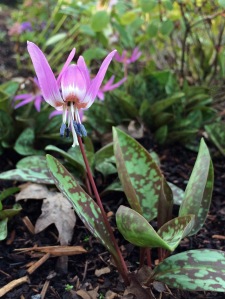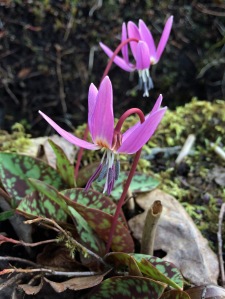This little gem – Erythronium dens canis – grows wild in favoured places across Europe. You might come across them in dappled shade on the edge of UK woods, pushing their way up through leaf litter, but there is probably more chance of finding them in a major garden or a spring plant and bulb catalogue.
Common names include dog’s tooth violet and trout lily. If you were wondering, dog’s tooth refers to the shape of the bulbs (which should be planted pointy side up) and trout to the beautiful, mottled foliage. The leaves look like a trendy, new, mint flavoured chocolate might – thin, of course, to justify the price tag in that inverse way we’ve come to expect; wavy to give the research and development team something to think about; and with a weird ingredient for extra credibility, such as cardamom or Kaffir lime leaves or green tea.
The flowers (the real ones, that is, not some chocolate fantasy) have a windswept look, balanced on outstretched stems as if they’re trying to escape their roots.
These pictures may or may not show the same cultivar – the one on the left was labelled Erythronium dens canis ‘Old Aberdeen’, but the others were unlabelled. The cultivar is characterised by rich chocolatey markings on the leaves, deep pink petals and inky blue anthers.
I found them all growing in humus-rich soil yesterday at the RHS Garden Harlow Carr in Harrogate, Yorkshire. The woodland walk was lovely, with primroses, daffodils and many other carpeting bulbs in bloom, so well worth a visit if you get half a chance.
I’m linking to Cee’s Flower of The Day.




Looking for the dog tooth violet each spring is a treasure hunt here in Ohio. They don’t last long. Ours seem to be only yellow.
I like all erythroniums but one of my favourites is a very pale yellow cultivar, despite the name – Erythronium revolutum ‘White Beauty’. Sarah Raven describes it well: ‘refined, haughty and unusual’.
Lovely! We propagate them here at the nursery and they are surely a wonderful woodlander. A native here as well!
I think I’d have a whale of a time looking at the many plants at your place, assuming I could get to them for all that snow!
This is so beautiful, Susan!
Sunny greetings from the Rhine Valley. x
Thank you, Dina! It has been sunny and calm here for the last few days – that’s what tempted me out with my camera.
A lovely plant; I remember seeing it for the first time at Sissinghurst many years ago, but seeing them always reminds me of that visit.
Happy memories then! I’ve only been to Sissinghurst once but I hope it won’t be long before I’m back again. I’ll always remember the kindness of one of the volunteers who insisted on giving us a lift to another garden nearby which would have been hard for us to find otherwise.
Oh that’s very special. NT staff are all so good aren’t they.
Yes, yellow in Maine.”Refined, haughty, and unusual” are quite the descriptions.
It’s easy for us to ascribe human characteristics to plants – no wonder people talk to them!
So true!
Here in southwest Virginia trout lilies are bright yellow. Still beautiful no matter the color.
I agree! I’ve seen a few small patches of the yellow ones recently but find them more difficult to photograph – they seem to dazzle my iPhone!
They are simply delightful!
They are a great way to brighten a shady corner.
Oh how very beautiful. 😀
I’m glad you like them.
Are they related to pulmonaria group? The leaves bear some resemblance.
I see how one might think so. Pulmonaria is in the Boraginaceae family, while Erythronium is of the Liliaceae.
Thanks for the info👧
They do. I like those a lot too – but then it would be hard for me to think of a spring ephemeral I don’t enjoy seeing.
There was a time I was addicted to silk flowers and spent tons of money just because I wanted to preserve what is beautiful.
There are some great imitations in silk or freeze dried – you’d be hard placed to tell them from the real thing, other than that they stay fresh looking! You’ve reminded me of some amazing little ceramic flowers I saw at a crafts fair in Mississippi – they were very true to life.
Any pictures?
Gorgeous and luscious! We have the yellow ones (E. americanum), when I looked up this variety, sadly found it isn’t widely available stateside. I was amazed to learn there are 20 species and research has shown that when the bulbs are inoculated with endomycorrhizal fungi, they thrive to nearly double the size. Fascinating relationships of nature!
Nature rewards things that are mutually beneficial, if not downright altruistic. I’m not sure whether our erythronium wouldn’t grow or it just hasn’t made it over there in any numbers yet. I’d guess the latter, in your climate at least. You already have an embarrassment of riches when it comes to erythroniums – we only have the one that would count as native, though that term is much less commonly used here.